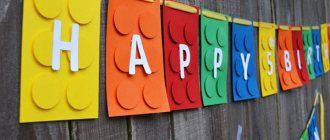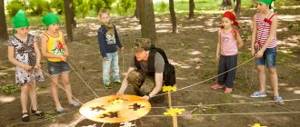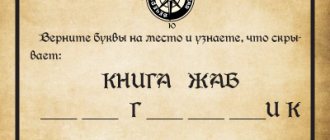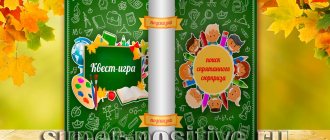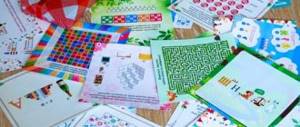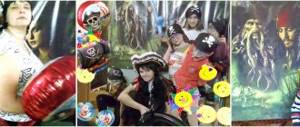Table of contents
- What to pay attention to when writing assignments
- Puzzles for the quest
- Riddles for quest house (in apartment)
- Riddles for an outdoor quest for children
- Codes for quests at home, at school, on the street
First, watch the video where we talk about the most popular letter riddles for the quest:
On our YouTube channel you will also find many other useful tips for conducting indoor and outdoor quests, go ahead and subscribe. New useful videos are released every week.
Plot and mechanics
I'll try it very briefly. You can't just give kids one puzzle after another. You need to come up with or borrow a ready-made plot and main characters from literature or cinema, define a goal, and think through the obstacles on the way to this goal. And to overcome obstacles you will need all these tasks (game mechanics).
Well, for example, the fairy tale “Kolobok”. For a happy ending, Kolobok needs to collect some clues from each character. The Hare, Wolf and Bear just don’t give anything. At each stage of the game you need to solve their tasks, get a letter, and form a password word from the letters. Hearing this word, the Fox will apologize for her predatory thoughts and take Kolobok back to his grandmother and grandfather.
This is a primitive example, of course.
The topic can be anything. I give you these free scripts with ready-made materials for download:
Culinary quest “Ratatouille”, Mysterious quest “Treasures of the Egyptian Princess”, Quest in the apartment “Haunted Bunker”, Country quest “Cave of the Three Parrots”, Quest based on Conan Doyle’s “The Lost World”, Game for little girls “Quest for Princesses” , Apartment quest “Night at the Museum”, Quest for grades 4-6 “The Secret of the Old Compass” (up to 30 participants).
There are also several scenarios from readers of the site with quest tasks in an apartment and in nature. Using these examples you can see how individual tasks fit into the plot.
What to pay attention to when writing assignments
Focus on the age of the children and their number. Basic rules that should not be forgotten: the more children there are, the simpler the puzzles should be, but you can make them bigger. This way, each participant will have the opportunity to both find the clue and solve the task. The same rule applies to children 5-7 years old: they still don’t have enough patience to solve a complex puzzle for a long time, but running around and looking is just the thing. For children aged 8-13, the riddles can be made more complex and the answers less obvious.
And do not forget, when preparing the quest, to create a sequence of caches for yourself along the chain in the order in which you will hide the clues at home or on the street. Each clue will point to a hiding place where the next one is hidden and so on, and the last one will show the children where the gift or sweets are hidden. For detailed step-by-step instructions on how to make a quest for a child yourself, read our article here.
How to use these sample quest assignments
These ideas are for creative people. Such people read the description of the quest task, and suddenly come up with something completely new. They don’t just change words and pictures, but create a new puzzle that suddenly “flies” into your head. There is even a book, “Steal Like an Artist.” Look for the old, make your own arrangement, create something new, passing through the experience of your predecessors.
The cheat sheet contains examples of collective collecting and my personal “arrangements.” Use, inspire, create.
Let me remind you that all this is suitable for those who conduct quests for their children or students. There will also be something useful for professional presenters, but you need to use real game props.
Puzzles for the quest
Puzzles about household items for the quest
Let’s say right away that we recommend including puzzles in the quest for children who already know how to read. And before solving puzzles, you need to either make sure that your children know how they are solved, or describe the basic rules for solving them:
- the rebus can be combined: drawn with a picture, written in letters and numbers;
- one or more commas to the left of a word means that you need to remove as many letters from the beginning of the word as there are commas. The same thing, if commas are to the right of a picture or word, you need to remove the letters from the end;
- if a crossed out letter is drawn under or above the picture, it must be discarded when reading the solution. If the number is crossed out, we cannot read such a letter;
- Also, letters in a word can be rearranged: then the order in which they need to be read is written above the word.
Some puzzles only involve the use of letters, prepositions and conjunctions that signify the interaction between letters: for example, “o” runs to “a” - we read “O to A” - Oka. The drawn syllable “pr” consists of many letters “y”. We read “PR from Y” - prizes. In the letter “o” the syllable “da” is written inside, we read “in O DA” - water. And so on, using any conjunctions and prepositions.
You won't need any great artistic abilities, but be careful when composing puzzles and choose not very complex pictures (or consider the possibility of getting a hint from you or another assistant).
We have compiled for you puzzles for children's home quests with solutions and answers. Study our examples and you will understand how to create any puzzles for finding a gift in an apartment (or use ours - we don’t mind).
Rebus about a closet: draw a scarf, write an explanation under it: 1 K 2 4. How to solve? You need to read the first letter Ш, followed by the letter K and the second and fourth letters: A and F. You get a “cabinet”.
How to make a puzzle for a complex word, for example, “refrigerator” is quite a mystery. The solution is this: any long word can always be mentally divided into two or three small ones. The rebus about the refrigerator will work out great by guessing two words: hunger (hungry man, change the first letter to “x”) and alarm clock (subtract the first two letters). This is what such a card will look like; we have drawn all the puzzles here at once with an explanation of the solution and the answer for your convenience.
Using the words “one” and “bath”, we decided to encrypt the rebus about the sofa : from “one” we subtract the first and last letter using commas. We subtract the last two letters from “bathtub”.
The rebus about the TV for the quest looks a little more complicated, but also more interesting: let’s draw a phone and subtract (with commas) the last three letters from it. And the rest of the word, “visor,” sounds just like “B, made from OR.” So let’s draw the letter “v”, made from the syllables “or”. It looks unusual, and you need to think to figure it out!
The simplest rebus in the world is about a table : after all, it is the number 100 and the letter “l”!
The rebus about the mirror is complex and not so simple: we encrypt the first part of the word through “grain” without two letters, and “kalo” sounds as if the syllable “lo” runs to the letter “a”, so let’s draw them! Let's get ZER + k A LO - there was an interesting riddle about a mirror.
Everyone has probably seen the pillow puzzle Pillow. This is our pillow.
a rebus about the oven with a picture and letters : “perfume” without the last letter and the letter “o” in the syllable “ka”. As you can see, we didn’t draw it very beautifully, but it’s quite understandable, in a hurry, to show you that you don’t need to be Picasso to draw a simple rebus.
And the rebus about the microwave from “microbe”, “wave” and again, “o” in “ka”, and subtract unnecessary letters in the first pictures. Children will definitely love this riddle about a microwave!
In solving the puzzle about the balcony , you can see that it was very easily made up of “squirrel” and the letter “n”.
Using a picture meaning “blood,” we made a riddle about a bed . We designated all the letters of the word with numbers, and how to read them and what letters were added is explained by the code: 1 2 3 4 A T 5. Taking the letters of the word “blood”, we made up “bed”.
The easiest way the rebus about a washing machine for a quest is to encrypt it with an abbreviated name (the children will already guess the answer from the first word anyway) “washing machine”: draw bones and a stick, subtract the first two letters from the bones, and replace the first letter from the stick with “r”.
The pictures “cat” and “knife” will help us to create a puzzle about the window : under the pictures we indicated how to rearrange the order of the letters and which ones need to be read.
to draw a riddle about a backpack : we’ll draw a glass and a lock and cross out those letters that don’t need to be read.
Puzzles about street objects
To encrypt the rebus about the door , draw “two” and replace the last letter with “e”. And in the word “lantern” we cross out the first four letters.
What pictures will help you come up with a puzzle about a bench for a quest? “Scat” and “watering can” immediately came to our minds. We cross out what is unnecessary, replace one letter - voila, the bench is encrypted.
Three herons in the forest, or how to make a puzzle about a ladder for a quest: draw a forest, the number three and a heron.
Let’s replace one letter, cross out unnecessary letters, and get “forest+tni+tsa”.
A few more thoughts about cards
If we talk about large-scale quests, for example, about a city quest, then any mapping service, be it Google, Yandex or 2GIS, can become the basis of the game; all that remains is to “screw” the logic for encrypting points and tasks to them. Such quests are usually created for adult teams and often use street intersections or coordinates.
We hope that we have directed your thoughts in the right direction and then you can easily find a suitable map option for your quest. Well, if suddenly you still don’t know about the existence of ready-made quest scripts that save hours and days of your time preparing home quests for the price of a couple of mugs of coffee, then you are welcome to the scripts section.
Riddles for the quest at home (in the apartment)
What if you don't feel like drawing a puzzle or creating a text riddle? That's okay, there's a great way to present the prompt differently. Here are some illustrative examples.
Letters in balloons
There is such a task in one of our quests, “The Case of the Stolen Cake.” You will need balloons according to the number of letters in the word (or more if you want to add empty pieces of paper - decoys).
For example, a riddle about a FIREPLACE, or a DRESSER, a CARPET (or any other word!) is simply 5 letters written on pieces of paper, and the pieces of paper are stuffed into balloons, which are then inflated! The guys have two options: read the letter through the balloon or burst it. If the word is long, write its number in the word under each letter. And before popping the balloons, you can play with them (for example, dance with the balloons, or not let them fall to the floor while music is playing, or exchange balloons in the air in a circle between participants).
Connect the dots
An excellent riddle about objects that are easy to trace, for example, a riddle for the words “chair”, “armchair” or “iron” . Just draw and number the dots (or label them with letters of the alphabet, then you will need to connect in alphabetical order). Moreover, you can use the alphabet, for example, English, or ask the numbers to be combined in descending order. You yourself control the difficulty of the task depending on the age of the children who will complete the quest. You can distribute tasks into easier and more difficult ones, and indicate who exactly solves each given riddle.
This is how the fork was encrypted in our New Year's MegaQuest: among all the icons you need to find and connect only the letters of the Russian alphabet.
Cross out the repetitions
Draw a square and divide it into squares; for younger children, 6*6 squares are enough; for teenagers and adults, 10*10 squares are possible. Fill the square with repeating letters of any word on the topic of your quest, or with any words at all, but not used in the word of your hiding place, also write its letters in the square. In the task, write that you need to cross out such and such letters and see which ones remain, and then make a word.
For example, the riddle about the closet from our Dinoquest: cross out all the letters D, I, N, O from the table. What letters are left? Make a word out of them. Having crossed out all the unnecessary letters, the children will see that the letters of the word “cabinet” remain. It’s so convenient to make up riddles about a clock, a window, a table, a sofa, a door (that is, short names of hiding places).
Word riddles
It’s very interesting to come up with descriptive riddles: “The clue is in your room, on the largest object on which there are two squares in bags ( riddle about the pillow ).” "Look for a new clue in the hot box." Without clarification, you will have to use your brain to guess that this is a riddle about the oven .
Examples of tasks:
Demining a Bomb Bombs look different, but the essence is the same - you need to quickly and correctly determine which wire to cut so that the sound signal does not go off.
Comparing Fingerprints For the experienced forensic scientist, fingerprints are a wealth of material to study. For everyone else, it’s difficult to find even just identical prints. Participants only have two attempts! If you enter an incorrect code, the system is blocked.
Laser alarm Ingenuity, flexibility, balance and caution! The most attentive ones can overcome the laser web.
Using a smartphone Tasks can be very different: searching and reading QR codes, receiving instructions on a gaming phone via email or SMS, listening to hints in audio recordings, photo tasks, tasks to unlock the phone.
Ultraviolet Using special flashlights, you can read hidden texts and messages, find marks on furniture and walls, and recognize fingerprints and footprints.
Cryptexes Cryptexes with a numeric or letter code always arouse the interest of players. The cylinder comes in two versions: just a hiding cylinder and a cryptex flash drive. Players need to obtain the code to gain access to the information.
Tasks on a laptop For quests, special programs are often written with a countdown or a password entry field. If the players do not have time, an explosion sounds and the system self-destructs.
Technical specifications of the System can be very different. Somewhere you need to guess and immediately connect the parts correctly according to the diagram. In some cases, players use the selection method. As a result of the efforts, the cache should open.
Opening locks, safes, boxes Classic quest set: various locks: combination and ordinary, boxes, safes, chests, chains, hiding places in the most unexpected places.
Chemical experiments and tasks Tasks with chemicals can be very different. For example, you need to mix solutions and powders to get a certain color, and then find the resulting shade in the color table, where an important code will be indicated.
Blind object search One player is blindfolded and wearing a helmet with a video camera. He may be in another room or a considerable distance from his team. The rest of the players see the picture on the monitor and control the “blind” player via radio.
Neurogame "Mindflex" Neurogame MindFlex Duel allows you to control the ball using the power of thought! The game has a battle mode - a struggle between the powers of thought of two players. The real Jedi wins!
Labyrinths Labyrinths come in different shapes and sizes, and there are many options. For example, you need to guide the key along the only correct path to open a new puzzle.
Games of dexterity and accuracy These are team tasks with unusual props. The success of the entire team depends on each player, so you need to do everything carefully and carefully.
Riddles for an outdoor quest for children
Any street riddle should be solved fairly quickly; it is better to do more of them than to rack your brain for 10 minutes over each task. Still, a quest on the street requires more dynamics than at home. If possible, do not use small puzzles or cut-out pictures to prevent the pieces from being blown away or getting lost. Make sure that in a public place your clue is not accidentally discovered ahead of time by other children or passers-by; here it is better to hide it more reliably. If the weather is cloudy, protect the tips from rain with a bag or cover them with tape.
Description of the item in your own words
Adjust the volume of text according to the age of the children. For example, for younger people, a riddle about a garage looks like a simple description in your own words: “Look for a clue in a special room for cars.”
Description of an object by definition from Wikipedia or books
For a child 8-12 years old, you can even riddle about a swing : “A movable structure with an axis of rotation, a structure for fun and entertainment, which is installed in parks, courtyards and recreation areas.” You'll have to think before you run in search of a clue.
Cards for adults
Cards for adults can be found in the extraordinary AlcoQuest.
What the game is about - to find a cache of drinks for the party, guests need to complete a quest.
For example, on the card you will see a mojito recipe. But take a closer look, a strange ratio of ingredients is not the best combo for guests. Of course, you shouldn’t try to make such a cocktail. And all because there is a hidden “message” on the card that will bring players closer to the cache.
Answer: lamp.
Codes for quests at home, at school or on the street (with answers and keys)
We have a variety of interesting codes in stock for children's quests; we will show you the easiest ones to prepare. Such ciphers are also suitable for quests for schoolchildren: they are solved quite quickly and you can quickly look for a new clue - after all, everyone wants to participate, and waiting in line can be difficult.
Code with pictures
Draw the key to the cipher: line the sheet into 33 sectors (fewer are possible, then you decipher only those letters that you use, plus a few more unnecessary ones). Let each letter correspond to any picture. In our detective quest, images on the theme of detectives and detectives can be any drawings, symbols, geometric shapes, dots, lines. The main thing is that children understand the principle of solving - to substitute letters instead of symbols.
Code from the first letters for the quest
It is similar to the previous version, but here the images do not mean a specific letter, and the child needs to take the first letter of the word that means this object. It’s easy to draw such a code: “n” - socks, “e” - spruce, “o” - cloud, “ya” - apple,” etc.
This is how the word “duvet cover” is encrypted in our New Year’s MegaQuest. For you it may be a riddle of another long word, for example, “window sill”, “computer”. If the word contains the letters “ы”, “ъ” and “ь”, write them immediately in the correct cells.
Codes for quests for teenagers are more complex, but solving them is more interesting and easier for older children (from 10 years old). We will give examples, for your convenience, ciphers with answers.
Caesar Cipher
In this encryption, letters are encrypted with other letters, which can be found by counting a certain number of steps from the encrypted letter. You choose the step of shifting the letters relative to each other yourself and it is the same for all characters.
How to encrypt: write on a piece of paper the alphabet of letters that we will encrypt (in our picture it is red). We decided to encrypt by shifting 1 letter to the right (you can do 6 to the left and any other combination). Then instead of A we will write I, instead of B we will write Z (the alphabet for encryption is blue in our photo). You must leave these two alphabets on the sheet - a hint, this is the key to the code. And below - write the encrypted (blue) word, the child must translate it into red, true letters.
this shift, the riddle with the word “TV” the riddle with the word “toilet” looks like STYAKDS. To decipher, the child will move 1 character to the right, getting T instead of C. Instead of D - E.
For teenagers and adults, you can specify the following key for this cipher (without drawing the alphabet): B = V, P = R, F = Z. The main thing is to carefully encrypt the word yourself.
Cipher "Lattice"
To encrypt a word, write it letter by letter in the cells of a large square (as in the photo), in the remaining squares write any other letters. Cut out a second square of the same size and cut holes in it exactly in the places where the letters needed to read the words are located. The solver will need to attach a grid with holes to a square with letters exactly so as to read a word of 6-8 letters, for example, take for the riddle the words “backpack”, “toilet”, “vacuum cleaner”, “battery”, “bed”, “ balcony". This riddle will require ingenuity to solve!
What's included in the price
Each game is discussed in detail with the manager, and the final cost depends on the set of activities and the number of locations. All games last 2.5 hours.
Minimum order - 96,000 rubles.
Up to 35 participants (the amount is the same for 10 and 35 players)
Each additional player - 3000 rubles.
- Services of a quest leader;
- Actors in characters - from 6 people (for 35 players);
- Organization and implementation of turnkey games;
- Quest scenery;
- Installation of props 4 hours before the start of the quest; dismantling props and scenery;
- Adaptation of the script at the request of the customer;
- Preliminary distribution among teams;
- Printing: printing of gaming materials, team kits, writing and stationery;
- Invitations in electronic format;
- Photographer for the duration of the quest;
- Game duration: 2.5 hours
- Delivery of props (500 kg!);
- Full-fledged props: gaming stations, interactive arcades and attractions; 18 banners on stands measuring 100x200 cm, props for station surroundings (chests, pillows, carpets, hookahs, safes, weapons), cryptexes, computers, lanterns, paintings, gas masks.
Summarize
In this article we have given many specific examples with riddles, puzzles and codes about household items and street objects. You can use our recommendations to come up with your own or take our ready-made options and just copy them. It’s not difficult to come up with cool, interesting riddles for your child’s birthday or just to have fun on the weekend! Don’t forget to include outdoor games in your quests (especially street ones) - it’s good for children to take their mind off codes, burn off energy and get moving. We tell and show examples of outdoor games in this article. Check out this article for active exercises at home.
Play with pleasure, and if you always want to have a sea of ready-made ideas in stock, subscribe to our fun Instagram, where we share free games, tricks, and crafts for all occasions. We wish you inspiration and joyful moments spent with your children!
Quest game for children indoors
At home, in an apartment
One room is enough for this, and if you have several of them at your disposal, great! The advantages are that you are not limited in time, you know your home well and where you can use interesting hiding places in it, and you can also gather at home for any occasion, even just invite friends over in the evening! A quest game for home can include any of the tasks listed above, except for running and very active games.
Arrange a quest game with parents and children, everyone will be interested: adults can help with some tasks (fill out a crossword puzzle together) or give hints for a completed task. For example, grandma has a hint, but she will only give it away for a song sung collectively. Or dad has a hint, but you can get it by beating him at chess. Any tasks, the main thing is that all participants enjoy the process.
Remember that tips should not be at heights or in hard-to-reach places. It also doesn’t hurt to remove unnecessary, distracting, and fragile items. It is better to alternate answers to tasks so that first you have to play in a large room, then run to the kitchen, then look in the bathroom, look into the bedroom and return to the living room again, and the finale will happen in the corridor.
Holiday in a rented studio
More often this is a quest game for a child’s birthday and a large group of friends. The advantages of this option are that you can use moving, active tasks without the fear of smashing everything around. And often in such places there are interesting additional props (soft sticks, climbing frames) that can be used in games.
Create a game script for a children's quest for children in this way: no more than 7-8 tasks that alternate. First, a diligent task on logic (for example, encryption), then something active and fun, for example, a game with balloons. Next is a search task, to find 15 plastic Kinder eggs in the studio, and in them are puzzle pieces, or letters on pieces of paper. Afterwards - a game to remember the sequence of objects. The next task is active, the game “Repetition” is suitable. The presenter says one thing and does another (as in the game “nose-floor-ceiling”), and the children must not make a mistake and do exactly what he says. Next is a counting task - children must find all the colored pebbles or kinder toys in a bowl of cereal; the correct number will help them unlock the phone and see a message with a hint. You can complete the quest with a fun relay race: when everyone runs, the fastest ones will receive a hint and everyone will find out together where the cache with sweet gifts is!
Holidays in elementary school
You need to entertain the whole class, and in such a way that everyone takes part. The best solution is to divide the class into 2 teams, and they will complete the quest at the same time: the tasks will be the same, but the answers (and hiding places) will be different!
To complete the quest mission, each team must complete it completely. Do not forget that in this case the caches should not intersect or even be nearby: if one team says “window”, then the second one can no longer write “window sill”. “Table” and “desk drawer” also cannot coexist; “door” and “doorknob” cannot. It’s better to use not only the classroom, but also the adjacent hall and corridor, or you can make it so that the children have to run to the cloakroom, to the gym, and even to the library!
The classic detective quest based on notes “In Search of the Missing Cake” for primary school children is just for such cases. And “Superhero Quest” is a series of sports and outdoor games and tasks that will allow kids not only to collect and neutralize the Bad Guys, but also to feel like superheroes and burn off energy!
Holidays in high school
The occasion can be any - a quest for the new year, March 8, February 23, autumn ball, birthday party, the beginning or end of the school year. The children have matured, they know how to work in a team, and all the available rooms in the school will be useful in the quest: each task for children is located at a distance from others and is accompanied by an adult.
For example, a quest game for older children “Doctor Spiralius's Antivirus”: children are divided into 3 teams and each go through 6 stages, collect 18 pieces of the map, which indicates where to look for rescue kits. And then they help the doctor with an anti-virus vaccine through a spectacular experience - this is a real adventure for children!

